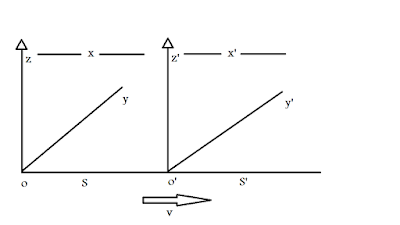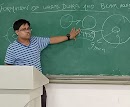Lorentz Transformation: A Simplified Overview
Okay…. there are already a lot of articles and books have been written on this topic, but still, I need to cover this for two main reasons. First, my upcoming articles will be based on this topic and I don’t want my readers to have trouble while finding adequate material to understand this topic. Second, as I have also studied many articles and books about this topic, so while reading them I always felt that there is always the ‘student’s side’ of the explanation was missing from the text. So, in this article I will try to include that.
Lorentz transform plays a critical and fundamental role in the space
of relativity. Without it you cannot derive the expressions for the popular
theories like length contraction, time-dilation and popular equation of mass-energy
relation, e = mc^2. So, by this I hope you can understand the gravity this
topic holds.
The Lorentz transformations are named after the Dutch physicist Hendrick
Lorentz.
Before, we start the derivation of the transformation, we need to keep
two postulates in our memory:
1) These transformations will follow the principle of relativity. The principle
of relativity states that, all laws of classical mechanics are valid in any two
coordinate systems moving uniformly relative to each other
2) The universal constancy of the speed of light in vacuum will not be
violated
So, now you are ready to jump into the juicy derivation part….
Derivation of Lorentz transformations
Suppose, there are two co-ordinate systems, S and S’. The space and
time coordinate of S are x, y, z and t, and for S’ they are x’, y’, z’ and t’.
Now, suppose, in the course of motion of S’ relative to S in the
x-direction with a speed v, a flash of light is emitted at the origins of S and
S’ when they were just coincident. Let’s identify that instant as t=0=t’.
So, for each observer, the flash of light would spread out like a
spherical wave with speed c according to two postulates, so for each wave,
Time = Distance / speed
t = √ (x² + y² + z²) / c
c² t² = x² + y² + z² (1)
Distance = √ (x² + y² + z²), because it has 3 axes.
Equation 1 is called a Spacetime interval equation.
Now, as the spacetime interval is invariant, we can write,
x² + y² + z²- c² t² =
x’² + y’² + z’²– c² t’² = 0 (2)
I will write another article to prove equation 2, so, stay tuned for
that…
Since the relative motion occurs in the x-direction, the y and z
coordinates should remain unchanged,
y = y’
z = z’
Now, after substituting this in equation 2, we get,
x² - c² t² = x’² – c²t’² (3)
Now, from the figure, at O’, x’ should be 0 but x is vt and at O, x is
0 but x’ is -vt. So, we can write,
x’ = k (x – vt)
(4)
x = k’ (x’ – vt’) (5)
where, k and k’ are the constants and added for precise measurement.
From eq. (4) and (5), we eliminate x’,
t’ = k [ t – (x/v)(1–1/kk’)] (6)
Now, from eq. (3), (4) and (6),
x²- c² t² ≡ (k²)(x² – 2xvt + v² t²) – c² k² [t² – (2xt/v)(1 – 1/kk’) + (x²/v²)(1 – 1/kk’)²] = 0
(7)
By equation the coefficients of t^2, as eq. (7) is an identity and true
values for all values of x and t, we get,
– c² = k² v² – k² c²
k = 1 / √ (1 – v² / c² ) (8)
and this equation is known as Lorentz Factor
and by equating coefficient of xt,
0 = –2k²v + 2(c² k² / v) (1 – 1/k k’) (9)
Now, using Eq. 8 and 9 in Eq. 4
and 6, we get ,
x’ = x – vt / (√ 1 – v²/c²) (10)
y’ = y
(11)
z’ = z (12)
t’ = (t – vx/c²) / (√ 1 – v²/c²) (13)
Eq. 10, 11, 12 and 13 are known as Lorentz transformation or Einstein –
Lorentz Transformation.
Also, we can obtain the reverse transformation if we replace x’ with x
and t’ with t,
x = x’ – vt’ / (√ 1 – v²/c²)
y = y’
z = z’
t = (t’ – vx’/c²) / (√ 1 – v²/c²)
Now from Lorentz and its reverse transforms, if v << c then we can ignore the fraction involving v and c as its value will be much lower than one and subtracting it from 1 will give a result which will be approximately equal to 1 and thus we
can also obtain the following equations which are also known as Galilean transformation,
x’ = x – vt
y’ = y
z’ = z
t’ = t
It’s interesting, isn’t ???
In my upcoming articles, I will write about spacetime interval and how its invariant, 4-vectors, tensors etc. are very important to understand relativity and cosmology. So, I will be writing about these gems, very soon…
Once these articles will be available links will be provided here...
-Ratnadeep Das Choudhury















0 Comments